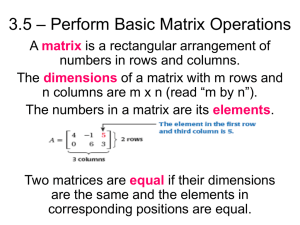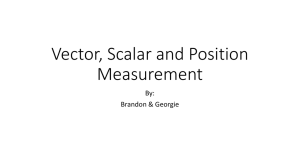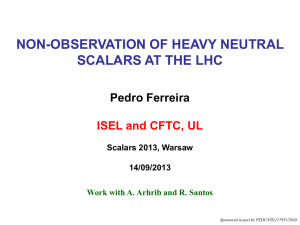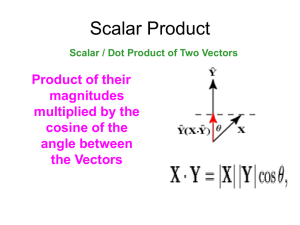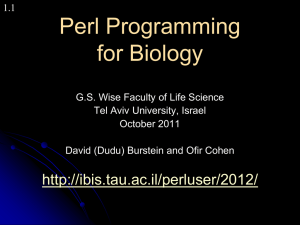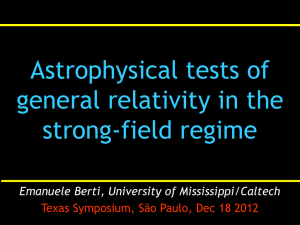Word Document
advertisement
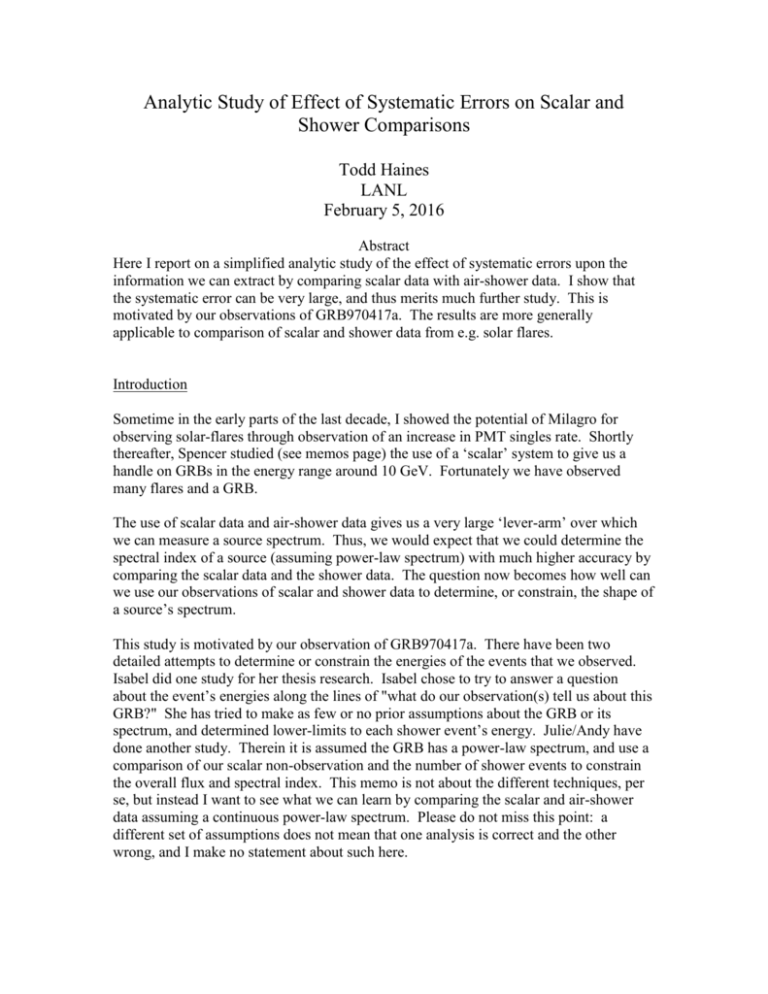
Analytic Study of Effect of Systematic Errors on Scalar and
Shower Comparisons
Todd Haines
LANL
February 5, 2016
Abstract
Here I report on a simplified analytic study of the effect of systematic errors upon the
information we can extract by comparing scalar data with air-shower data. I show that
the systematic error can be very large, and thus merits much further study. This is
motivated by our observations of GRB970417a. The results are more generally
applicable to comparison of scalar and shower data from e.g. solar flares.
Introduction
Sometime in the early parts of the last decade, I showed the potential of Milagro for
observing solar-flares through observation of an increase in PMT singles rate. Shortly
thereafter, Spencer studied (see memos page) the use of a ‘scalar’ system to give us a
handle on GRBs in the energy range around 10 GeV. Fortunately we have observed
many flares and a GRB.
The use of scalar data and air-shower data gives us a very large ‘lever-arm’ over which
we can measure a source spectrum. Thus, we would expect that we could determine the
spectral index of a source (assuming power-law spectrum) with much higher accuracy by
comparing the scalar data and the shower data. The question now becomes how well can
we use our observations of scalar and shower data to determine, or constrain, the shape of
a source’s spectrum.
This study is motivated by our observation of GRB970417a. There have been two
detailed attempts to determine or constrain the energies of the events that we observed.
Isabel did one study for her thesis research. Isabel chose to try to answer a question
about the event’s energies along the lines of "what do our observation(s) tell us about this
GRB?" She has tried to make as few or no prior assumptions about the GRB or its
spectrum, and determined lower-limits to each shower event’s energy. Julie/Andy have
done another study. Therein it is assumed the GRB has a power-law spectrum, and use a
comparison of our scalar non-observation and the number of shower events to constrain
the overall flux and spectral index. This memo is not about the different techniques, per
se, but instead I want to see what we can learn by comparing the scalar and air-shower
data assuming a continuous power-law spectrum. Please do not miss this point: a
different set of assumptions does not mean that one analysis is correct and the other
wrong, and I make no statement about such here.
It is also relevant to point out that Abe studies the shape of the spectrum that we could
infer from our observation of the Nov. 6 solar event. He too assumed a power law
spectrum with a cutoff. Though it seems we observed this event in the ‘100 PMT’ data,
his analysis was limited to the scalar information; his spectral shape was constrained by
our observations in comparison to the observations from neutron monitors at both lower
and higher geomagnetic cutoffs.
Analysis
I assume the GRB has a power-law spectrum:
dN/dE = A0 E-,
where the single power-law is assumed to be applicable from below our scalar threshold
all the way up to some cutoff energy E0, and there is no flux above E0 (one can make
other assumptions, like an exponential cutoff, but I do not do so here for simplicity).
Julie has calculated via Monte Carlo simulations the effective area for Milagrito for
gamma-ray events from the direction of GRB 970417a (see memos page for the plots).
These effective area curves fortunately can be fairly accurately represented by powerlaw’s in energy; the scalar system can be represented by a single power-law, the airshower area by a broken power law. Representing generically the effective area as
follows:
Aeff = A1 (E/GeV)-1,
I find the following parameters describe the Monte Carlo results within about 10%:
Energy range
Scalar Effective
area
Air-shower
Effective area
Air-shower
Effective area
All energies
50 GeV – 3,000
GeV
3,000 GeV –
100,000 GeV
Normalization (m2)
“A1” etc.
12.07
Index “1” etc.
1.68*10-6
2.68
0.1343
1.27
1.5
where it should be understood that the air-shower effective area appears to be a broken
power-law, and the scalar effective area seems to increase according to a single power
law, at least in the energy range reported in the memo.
Let me further suppose that the simulated effective area is A’(E) = (E)*A(E), where A is
the true value of the area as a function of E-- represents some systematic error in the
area prediction that may be in general energy dependant. All ‘primed’ values will
represent the number of events calculated from the simulated areas, the unprimed values
using the true areas. I assume the scalar system actually observed Nsc events, and we
observed Nas air-shower events.
Case 1: Single power-law/constant error assumption
In this section I want to make a further simplifying assumption, in doing so I will
illustrate some important points. So, I assume that both the scalar and shower effective
areas grow as two separate unbroken power-laws, using subscript 1 to represent the
parameters for the scalar areas and 3 for the shower areas.
I then calculate the expected number of events (counts) in e.g. the scalars by folding the
effective area as determined by the simulation with the assumed power-law source flux.
The result is
Nsc’ = A0 E- A’1(E) dE = A0 E- sc(E)*A1(E) dE
where the subscript sc refers to scalar system, etc., and the integration is taken over
energy from 0 to E0.
I assume the error function is simply a constant here (factor of 3, or 10%, or whatever).
To give some ideas of how we could have approximately constant errors, perhaps we
have over or underestimated our PMT’s efficiencies. Or, we have an overall error in our
energy scale so that E a*E where a is the overall rescaling needed; in this case, sc =
a^1, etc.
I carry out the integration and can solve for E0 as
E’0 = [(Nsc’/Nas’) (A3/A1) (as/sc)( (1 - +1)/( 3 - +1))]^(1./( 1 - 3))
Again we have used the ‘wrong’ effective areas and thus infer the ‘wrong’ energy cutoff.
The ‘true’ cutoff is simply determined by using the ‘true’ effective areas; these are
trivially calculated by putting as = sc = 1. Then the true value of the cutoff is
determined, and I find then that
E’0 / E0 = (as/sc) ^(1./( 1 - 3)).
The main lessons from this note can be taken from this result.
Let me discuss some features of this result. Usually we think of a systematic error on a
flux or energy scale being proportional to the error in the following manner:
E’0 / E0 = (as/sc) ^(1/ )
So that if the source spectrum has 2-3, then the error is proportional to the square root
or cube root of the error, probably a small error. This is not the case. Note that the result
is independent of the source spectral index and source flux. This is because there is no
feature in the data that somehow sets an energy scale—the overall scale can be shifted
without changing the inferred energy cutoff. The result depends upon the difference
between how the scalar and air-shower effective areas grow with energy.
This is not necessarily a small error. What we know is that the air-shower effective areas
for Milagrito are accurate to about 30%-50% because of our observation of Markarian
(see Isabel’s thesis for more detailed discussion)--as ranges from about 0.75 to 1.5. We
also know that the scalar system prediction is about a factor of 3 off from the observed
scalar rates (see Abe’s paper), so sc ranges from about 0.33 to about 3, and this is for
cosmic-rays, not gamma-rays. So, the ratio in the parentheses above can range from 3/16
to 9/2.
The above ratio is raised to a difference of exponents. The air-shower effective area
grows with an exponent of 2.68 at low energies, and as a power with exponent 1.27 or so
at high energies. Then the “error ratio” needs to be raised to a power of about 0.8, since
we are considering air-shower energies typically below 1,000 GeV. If most of our events
really came in above 3 TeV, then we would raise the above to more like the 4th power!
Case 2: Single power-law/power-law error assumption
Let’s consider a slightly different assumption about the error of our effective areas.
Suppose we’re worried not about some overall detection efficiency, but instead we are
worried about an error in air-shower simulation and propagation. (Note however that an
overall detection efficiency error will in general amount to an energy-dependent error that
will end up being about what I assume here.). For example, we have an error in height of
shower maximum, or almost equivalently, an error in our energy scale.
This will amount to an error that depends upon primary energy; I will assume it is a
power-law in primary energy for simplicity of integration (perhaps it is more accurately
described by a ln(E) function) as
as(E) = as*E^as etc.
One would think this type of error is equivalent to a re-scaling of the source’s spectral
index—that is to say, a systematic error in the growth of our effective area curves one
would imagine is no different than changing the source’s spectral index from to as,
depending upon the situation. This however is not the case, because changing the
effective area also changes what the source’s flux normalization appears to be. And since
by assumption we have the same normalization at 10 GeV and 10 TeV, this kind of
systematic error feeds into the problem in a more complicated way.
I have done this calculation and will illustrate the results without making anybody suffer
through the integration and algebra (it is straightforward and not much fun). The general
result is
E’0 / E0 = [(as/sc)^*(Nsc’/Nas’)^ (-1/(1 - 3))*(A3/A1)^(-1/(1 - 3))*^(-1/(1
- 3))]/ {[(1 - + 1)/( (3 - + 1)]^(1/(1 - 3))}
where = (1/( 1 + sc - 3 - as)) and = (1 + sc - + 1)/( (3 + as - + 1). Note
now that we have an explicit dependence of the error in energy scale upon the source
spectral index through the term; this makes some sense because of the energy
dependant growth of the two area errors. But there remains no dependence upon the
source spectral index in the exponents that any of these terms are raised to.
I for one cannot learn much more from the above expression because it is so complicated.
However, if I make the further simplifying assumption that sc = as sc so that the
growth (or reduction!) of the errors is the same for both scalars and air-shower area (Note
that this would not be the case if we had an overall error in our energy scale so that E
a*E where a is the overall rescaling needed; that case would need the full treatment
above.), then the expression simplifies considerably to become
E’0 / E0 = (as/sc)^(1./( 1 - 3)) * [*(( 3 - + 1)/ (1 - + 1))]^(1./( 1 - 3))
a very similar result to case 1. In this case, we still have a dependence upon source
spectral index. To understand if these ratios of indices are large or small effects, I have
plotted here for you the factor that multiplies the systematic error part [*(( 3 - + 1)/
(1 - + 1))]^(1./( 1 - 3)) as a function of source spectral index with 1 = 1.5 and 3 =
2.7. The x-axis is the index that describes the effective area error, the y-axis the value to
which one needs to multiply the factor from case 1.
100.00
3
2.9
Rel. Factor Error
10.00
1.00
-0.5
-0.3
-0.1
0.1
0.3
0.5
2.8
2.7
2.6
2.5
2.4
0.10
2.3
2.2
2.1
2
0.01
Error Index
The point here is that the systematic error can be very large, or very small, depending
upon the situation. The error index is likely ~0.1 or so, but it wouldn’t surprise me if it
were as large as 0.3 or so. Bottom line however is that we don’t know what it is, and the
actual error depends very sensitively upon the source spectral index.
Case 3: Broken power-law/constant error assumption
Now, it is certainly true that our effective areas are not exactly power-laws in energy. As
I mentioned above, the air-shower effective area grows more like a broken power law. I
have evaluated this situation as well analytically. I continue to take the scalars to behave
like a single power law and both scalar and air-shower errors to be constant, but now the
air-shower area grows like a broken power law.
In this case, the analytic expression gets quite cumbersome. I would be happy to
reproduce it for anybody interested, but I can tell you the salient points in words.
Basically, the cutoff E0 remains sensitive to the differences between the source’s spectral
index and the indices that describe how the areas grow. There is added sensitivity to the
energy where the effective area breaks, which I call Eas—this should be expected since
again we’ve a ‘fixed point’ on the energy scale. There remains a dependence upon the
ratio (as/sc) but now of the form (as/sc)^(1./( 4 - + 1)). From the simulation 4
1.27 so that the exponent is about 1/(2.3 - ); obviously this exponent is going to be of
order 3 to 10 for typical source indices.
Summary
Here I reported an analytic study of the dependence of the systematic errors on our
comparison of scalar and air-shower data, in particular in the context of determining a
cutoff energy in an assumed source power law spectrum. This study applies both to our
understanding of our signal from GRB 970417a and also upon our understanding of solar
energetic particle events.
This analytic study is not meant to replace a more accurate numerical study of systematic
errors; it does however illustrate some salient features of how systematic errors play into
the cutoff determination. What is particularly important is the finding that the cutoff
depends upon the relative air-shower to scalar systematic error raised to a power. That
power is not 1/, so that one is taking the square or cube root of the error. The systematic
error ratio is raised to a power more typically that is the inverse of the difference between
source and effective area indices, so that it may be quite a very large effect. Upon further
contemplation one should find that this makes intuitive sense.
Where does one go from here? Obviously we must understand what are our systematic
errors in effective area. We have at least one handle on this for our air-shower data. We
can at least put limits upon our systematic through study of our gamma-ray signals from
sources, and a careful comparison of our observations with other detection’s
observations. This was done in a very simple way in Isabel’s thesis, and should be done
more carefully.
We have no signals observed in scalar data except for our observations of bursts from the
sun. It is not necessarily true that the CR induced scalar rates have no bearing upon our
expectations for gamma-ray scalar signals; certainly some cross sections describe the
same phenomena in both types of showers. Moreover, we are lucky that the scalar data is
important in a primary energy regime where at least some accelerator data exists. But it
is probably necessary to dig into the simulation code to determine the effect of the
various physics processes upon our observations, and then study their associated
uncertainties.
Another suggestion is that a good understanding of the metrological effects upon our
scalar data may allow us a glimpse at the underlying physics processes important for our
scalar studies. In a sense, our scalar effective area is equivalent to counting the number
of particles out of some shielding in a high-energy particle beam. A common method of
checking the validity of the calculated radiation dose from shielding is to vary the amount
of shielding and predict the dose as a function of shielding. Pressure variations are the
same as putting more or less absorber in a beam; temperature effects are similar to
variations of the density (but not total amount) of absorber.
Whatever the solution to the problem at hand, it is certainly important for us to publish
our observations with as much quantitative detail as we can. This includes us addressing
our measurement errors in more detail as these errors may not be as small as we would
like.
